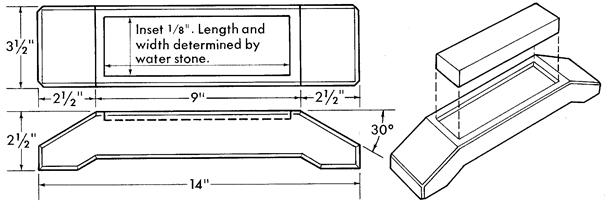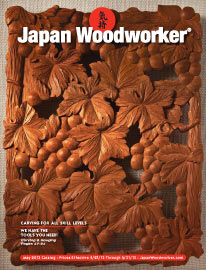|
|
 |
 |
 |
| The Care and Use of Natural Water Stones |
posted on 11:00am by David |
|
 |
A guide to tool sharpening and stone preparation and maintenance.
Introduction
Sharpening stone material has been mined in Japan for nearly 2000 years. About 1200 years ago, the best deposits were discovered in the mountainous Narutaki District north of present day Kyoto. Over the centuries, the easily obtainable deposits have been mined out. Today, laborious tunneling and mining techniques are required to obtain natural sharpening stones. All of the natural stones sold by the Japan Woodworker have been selected following a centuries old grading Particular care is taken to ensure we obtain stones of a more uniform size and quality than those generally available in Japan.
Basically, there are three categories of natural stones: Coarse stones for initial sharpening, medium stones for removal of the scratches left by the coarse stone, and finish (polishing) stones for final polishing to a razor edge. However, within each category there are numerous gradations and quality levels. Generally speaking, the coarse stones are in great supply and are inexpensive. The medium type stones are slightly more expensive. The finish stones, on the other hand, range from prices of $30.00 to over$2000.00 for the finest polishing stones used for sword polishing. Much of the lore surrounding natural stones is a result of their association with the polishing of Samurai swords. All of our natural finish stones (Awaseto) will give a better finish than any artificial stone.
Awaseto do not produce a mirror bright finish as do the synthetic stones. Japanese craftsmen believe the mirror finish obscures the surface of the bevel and does not allow as fine a determination of its flatness and sharpness. In addition, the Awaseto brings out all of the beauty of the lamination lines in the soft metal (Jigane) of the better quality plane irons much as the temper line in the Samurai sword is brought out by polishing. In practical terms, the actual difference in sharpness and longevity of the edge of tools sharpened by Awaseto and by synthetic stones.
Preparing Natural Stones for Use
Before initial use, the sides and bottom of all natural stones should be painted with several coats of weather resistant lacquer or varnish. It should be noted that natural stones are a result of millions of years of geologic action, and for this reason, no two stones are exactly the same. Natural stones may contain hidden faults or spots which may not be as fine as the rest of the stone. In this case, use a nail to scrap the spot or line slightly below the surface of the stone.
As you become familiar with your Awaseto, you may discover two or three different honing actions related to specific areas on the stones. This is typical of even the most expensive stones. In fact, you may discover you prefer to hone one tool on a certain area of the stone and another tool on yet another area.
Natural stones should only be lubricated with water! Oil or other mineral spirits will destroy the sharpening ability of the stone. Natural stones should not be left immersed in water for long periods of time as this could cause fracturing along naturally occurring fault lines in the stones. I place my natural stones into the water bucket at the same time I begin sharpening with the coarse stone. By the time the wire edge has been obtained, the Ao and Awaseto will have absorbed sufficient water to hone effectively.
How to Flatten Your Stones
Before initial use, all stones should be flattened after soaking for a short period of time in the water bucket. The Aoto can be flattened on #220 grit wet/dry sandpaper. The Awaseto can be flattened on a coarse stone which has been previously flattened. Be sure to place a narrow bevel (approximately 1/32" to 1/16" wide) on all edges of your stones by rubbing the edge on the wet/dry sandpaper at a 45° bevel angle. The reason the edges are beveled is to prevent pressure flaking,which can chip off flakes of material from the sides of the stone.
The Mountain Blue Stone (Aoto)
The Aoto is a unique stone in that it is found only on one mountain in Japan. The temple known as Dai Nichi Do controls the rights to all of the Aoto. These stones are difficult to come by as the villagers in the area are quite content with the income from their farming activities and have little incentive to undertake the demanding and dangerous task of mining for Aoto.
Once you have obtained a "burr" or wire edge on your coarse stone, it is time to move to the Mountain Blue Stone (Aoto). Honing the tool on a Aoto is the next and most important step as this removes the scratches left from coarser stones. The Aoto will rapidly remove the scratches left by a #1000 stone. Follow the same sharpening procedure for the Aoto as was used with the coarse stone.
Nagura Stones
The incredible polishing action of a finish stones results from the mud" which builds up on the surface of the stone during honing. Nagura Stones create this "mud" before honing begins, thus speeding up the polishing process. In addition, the Nagura Stone makes the stone surface slippier, keeping the tool from sticking. Nagura Stones are small pieces of very fine chalky natural stone, specially mined for this purpose.
A Nagura Stone is easy to use. Simply rub it in a circular motion on the full surface of a finish stone until a paste or "mud" develops. If the stone surface is too dry the Nagura Stone will stick To alleviate this problem, add a few drops of water. Generally speaking, the more paste, the better the honing action.
Final Steps
After the scratches have been removed by the Aoto, the final step is to hone the edge on the Awaseto until the wire edge disappears and the bevel is well polished. The most effective polishing action is obtained by first rubbing a Nagura stone over the surface of the Awaseto.
After use, natural stones should be placed on a rack out of the wind and sun and allowed to thoroughly dry out before being stored. With careful used, the more expensive Awaseto will last several life times.
Waterstone Base
Below is a drawing of a Japanese style base which is used to hold waterstones steady during sharpening. The base is easy to make, and the user can vary the design to suit his taste. Redwood or cedar is typically used. However, any water and warp resistant woods are suitable material.

|
|
|
 |
|
 |
|
|
 Click Here to View Catalog
Click Here to View Catalog